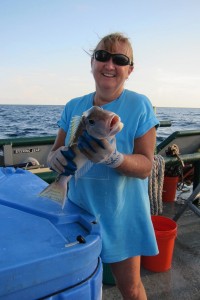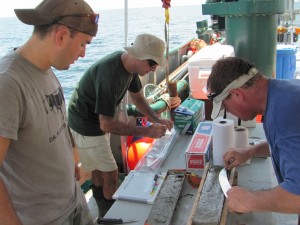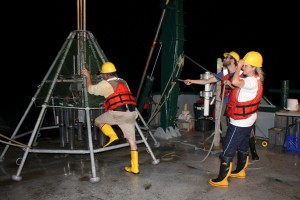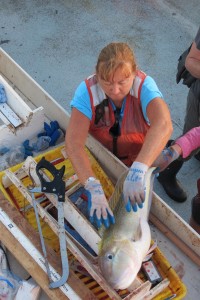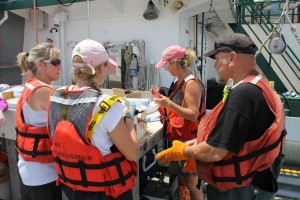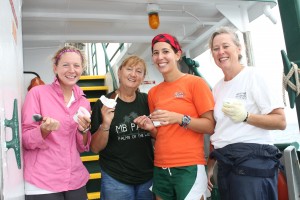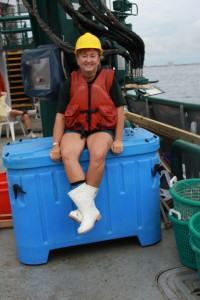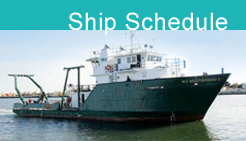Deep Sea Fish and Sediment Surveys in the Gulf
“Teacher at Sea” Post Cruise Closing Thoughts
By Patty Smukall
Dr. Teresa Greely asked me to sum up the experience of being the first “Teacher at Sea” for C-IMAGE. It is hard to express how the 8 day adventure aboard the Weatherbird II will influence my teaching, and the impact it will have on my future students in the few words of a blog.
Spending the week aboard the 115 foot R/V Weatherbird II is a privilege in itself. This research vessel has been instrumental in responding to the scientific need for studies of the area most likely affected by the Deepwater Horizon Blowout in 2010. Since that time, the Weatherbird II, operated by the Florida Institute of Oceanography, has made numerous expeditions to selected sites, collecting data that is shared with institutions and scientists all over the world. It has played an integral role in the collecting of geological, hydrological and biological samples.
Any research vessel is only as productive as the crew and science research parties manning it. It was the experience of living and working alongside these phenomenal and dedicated professionals that will have an impact on my professional development and ability to inspire my students to become the oceanographers of the future.
One of the most beautiful partnerships I have ever witnessed was the working relationship between the two science teams aboard the vessel. There was the biological team, headed by Chief scientist Dr. Steven Murawski, studying the potential physiological effects on the health of the fish caused by the Deepwater Horizon catastrophe. He was joined by three of his newest graduate students and a chemical environmentalist, Erin Polster from Mote Marine Lab (C-IMAGE partner institution under Dr. Wetzell).
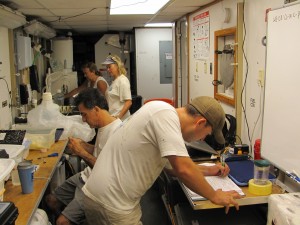
Scientists from many different disciplines sharing a very small lab aboard the Weatherbird II, all with mutual respect for the work each was doing.
At the other end of the science spectrum lie the fields of geology, geochemistry and paleontology. These distinct disciplines merge together and overlap when investigating the geological stories that can be deciphered through a study of sediment samples. The effects of the blowout on the sediment, the micro-fauna that live within the sediment and the chemistry of the water found just above the sediment were the focus of the team led by Dr. David Hollander and his team.

Dr. Teresa Greely collecting water samples to be filtered and used in the study of the microbial ecology just above the sediment surface. This research is being conducted by researchers at the University of West Florida (C-IMAGE science partner, Dr. Wade Jeffrey).
Each night, the team, under the supervision of post graduate, Patrick Schwing, sent down to the seafloor a multi-corer, a spaceship-looking structure that has the potential to collect eight core samples simultaneously at extreme depths. These samples are of such importance in piecing together the mystery of what happened, what the impact of the blowout has been and what the impact may be in the future. These samples are collected, transferred undisturbed to more permanent storage containers, labeled and preserved to be studied in detail by several different investigators. All of this hard work is time-consuming and at times dangerous. The process ran like clockwork and was repeated at different study sites two or three times each night. Once aboard, water samples from both above the sediment and within the sediment were collected, and will be shared with geochemists studying the chemical hydrology.
So there you have it; scientists of every background and interests sharing the work and the resources all at the same time. It came together beautifully. Unlike oil and water, the various disciplines of science do blend together to form a productive solution.
As Marine Science teachers, we know and teach that Oceanography is an inter-disciplinary science, encompassing the biological, geological, physical and chemical sciences. Yet, we each have come from a background specializing in one field, in my case, zoology. The next “Teacher at Sea” might have a chemistry or physics background. It is easy to forget that ideally oceanography is best studied as the inter-twined conglomeration of all the fields of science. Oceanography is the epitome of collaboration between disciplines. This interaction and merging of the fields was what impressed me the most about the research. In biology terms; it was the perfect execution of mutualism! These scientists showed mutual respect for the work of each other. Fish biologists interested in the composition of the sediment, geologists pulling long-lines, a deck-hand pulling in the CTD water profilng device, a journalist attaching a camera to the multi-corer, a chemical geologist helping the post-graduate process core samples in the middle of the night and the Dean of the College tying fish hooks onto the long-line. It was so inspiring to witness the sharing of work as well as the excitement of discovery. No egos in the way on this expedition. Everyone was cooperative and enjoyed exploring together. The collaboration allowed the goal of C-IMAGE to be reached, to show the interaction between the chemical fate of the contaminants in the system and their biological impacts.
This mutual respect and collaboration among scientists is what I hope to share with my students.

It was an honor to witness this type of collaboration, much less to participate in it. Here I am taking a core sample to the refrigerator for preservation after it has been collected, transferred to a storage tube and labeled.
I recommend participation in the C-IMAGE “Teacher at Sea” program for any teacher, especially a science teacher. The teacher is the best way to spread the message of ocean conservation with students for years to come. As for my advice for the next “Teacher at Sea”; bring more old clothes, lots of very old, disgusting clothes, clothes that you won’t mind disposing of in the closest trash can on the way home!
| Print article | This entry was posted by greely on August 24, 2012 at 1:52 pm, and is filed under Oceanic Updates. Follow any responses to this post through RSS 2.0. You can leave a response or trackback from your own site. |
